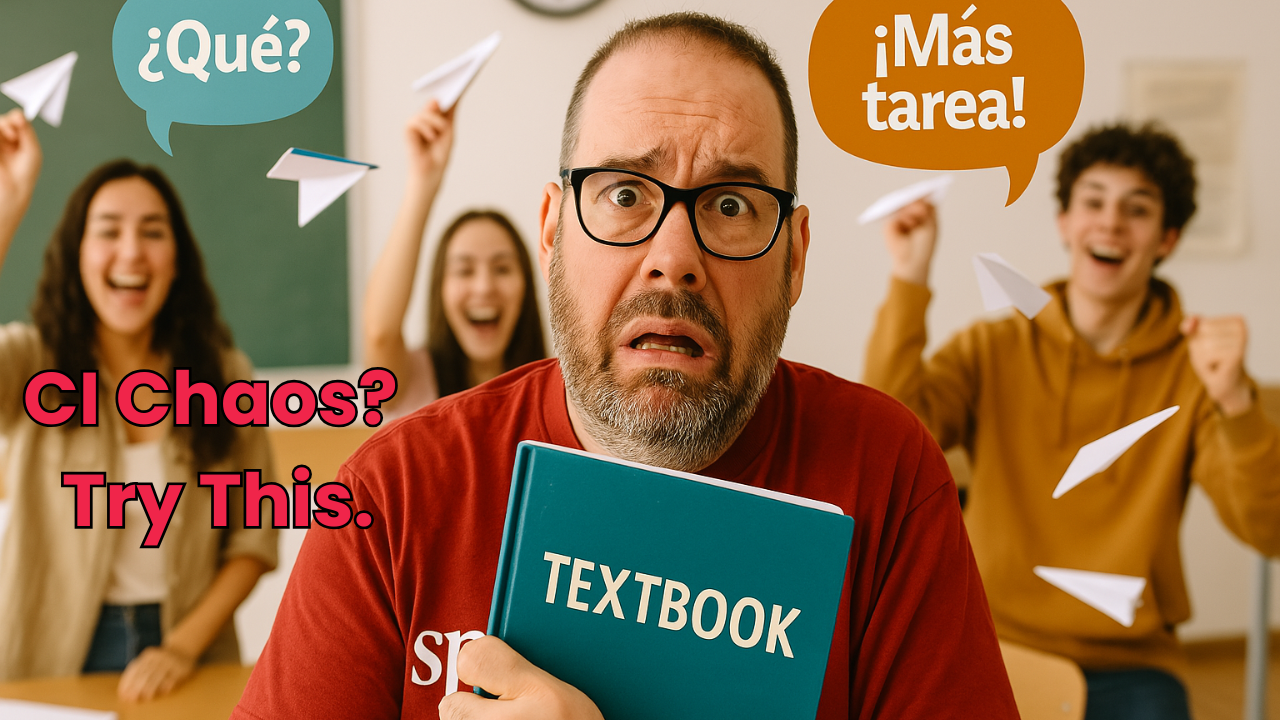
Management strategies that keep input flowing without resorting to punishment (or losing your last shred of sanity).
Welcome to the Jungle (a.k.a. 3rd Period)
You step into your classroom. The clock hits 12:02 PM. A pencil has already been launched like a missile. Three kids are under their desks for reasons unknown. Kyle is galloping. Again. And you—hero of the CI revolution—are trying to get through a story about a dog who eats socks. In Spanish. With a straight face.
You wonder silently, “Is this language acquisition… or is this the opening scene of a Netflix docuseries called ‘How the Chaos Won’?”
If you’ve ever asked yourself whether CI classrooms require chaos to function, you’re not alone. And if you've ever wanted to restore order without turning into Dolores Umbridge in Danskos—congratulations. You're the exact kind of teacher this article was made for.
Let’s bust the myth that CI = total anarchy. You can have an engaging, student-centered, target-language-rich classroom that doesn’t resemble a toddler birthday party at a trampoline park. You can manage your classroom without doling out detentions like candy corn. You can enforce boundaries while keeping the fun. You can have discipline that doesn’t kill the vibe.
And yes… you can even do it during 7th period on a full moon when there’s been an assembly.
Let’s go.
The Myth of “If They’re Loud, They’re Learning”
Let’s tackle the biggest lie told in CI circles since someone claimed MovieTalks don’t require subtitles: the myth that if it’s loud and messy, it must mean acquisition is happening.
Sure, sometimes a buzzing classroom means kids are engaged. But sometimes it means Jason is using the class puppet to reenact The Exorcist while you’re desperately trying to circle “quiere comer.”
CI isn’t about chaos. It’s about connection. Controlled chaos can be productive—but only if you’ve set up structures, routines, and expectations that support it. If you’re just vibing with whatever happens… welcome to burnout town. Population: you.
So let’s reclaim control. With humor. With grace. And with just enough sarcasm to keep your coffee from weeping.
🎯 Control Strategy #1: Silent Signals > Shouting Like a Medieval Town Crier
You’ve tried clapping patterns. You’ve tried chanting “1-2-3, eyes on me.” You’ve even tried the “freeze and hope someone notices” strategy.
But here’s the real MVP: Silent Signals.
Raise your hand and wait. Like a majestic, tired wizard.
Once one kid notices, others follow. And within seconds, it’s like Moses parting the Red Sea… if Moses wore cardigans and was desperately trying to get through a story about a frog that lives in a taco.
This works because awkward silence is kryptonite for teens. No one wants to be that kid still talking when everyone else has snapped into alert mode like it’s the Hunger Games.
You don’t have to yell to command attention. You just have to master the art of the pause. Pair it with a well-practiced glare that says “I’ve had just enough coffee to call your mom mid-class,” and boom—you’re golden.
Also? Narrate the chaos in the TL:
“Clase, miren… Kyle está gritando como un pato furioso.”
The class laughs. Kyle stops. You win.
🎯 Control Strategy #2: Rules Are Sexy (Yes, I Said It)
“But Scott,” I hear you cry through the void, “I want a student-led classroom! I want them to feel empowered!”
Cool cool cool… but even pirate ships have rules.
In a CI classroom, we need simple, crystal-clear expectations that support input and prevent meltdowns (yours and theirs). Not 87 rules. Just 3-4 non-negotiables that you practice like your Netflix password depends on it.
For example:
- Listen with the intent to understand.
- Only one person speaks at a time.
- Don’t lick the whiteboard. (Yes, it happened. No, I’m not over it.)
Practice these expectations with skits, mime routines, or exaggerated charades. “One person speaks” becomes a student shouting while the rest dramatically faint. “Listen to understand” becomes a slow-motion reenactment of someone straining to hear through a wind tunnel. Make it absurd. Make it funny. Make it stick.
Post them. Point to them mid-class. Praise them when followed. Narrate them when broken. Turn them into memes. Tattoo them on your soul.
CI thrives when students know the rules of the game—and when you, benevolent input overlord, enforce them with flair.
🎯 Control Strategy #3: The Sacred Art of Seating Charts
There’s a myth floating around that true CI teachers let kids sit wherever they want and float around like bilingual butterflies. This myth is brought to you by people who do not teach middle school.
Here’s the tea: strategic seating is your first line of defense against chaos.
Assign seats. Rotate them with intention. Keep your “needs frequent teacher eye contact to behave like a human” kids within your gaze. Give space to those who get swallowed by group chatter.
And when a kid says, “Why do I have to sit here?”
Answer: “Because I like my whiteboard, and I don’t want it destroyed.”
Bonus twist: give your groups fun CI-related names. “Los Churros del Caos.” “Equipo Drama.” “Los Profesionales.” It makes it feel like a team sport instead of the Hunger Games.
Think of your seating chart like a strategic battle map. Except instead of world domination, you're trying to finish one story without someone making fart noises. Lofty, I know.
🎯 Control Strategy #4: Make the Misbehavior the Input
Ever had a kid crawl on the floor mid-lesson? Jump up and shout “yo soy un gato!” while licking their own arm? (Also happened. Still not over it.)
Instead of stopping everything to hand out discipline slips, use it.
Narrate it. Story-fy it. Build it into your input.
“Clase, ¿Quién es el gato misterioso? ¿Por qué está en el piso? ¿Está buscando una galleta mágica?”
Suddenly, you're not dealing with a disruption. You're rolling with it—and modeling language as you go. (And yes, you might end up with a classroom story called “El Gato Loco Busca Una Galleta Gigante,” but hey, now you’ve got reading content for Friday.)
The point is: CI thrives when the language feels real. Use the weirdness. Don’t punish it—redirect it.
Just… maybe set a limit on licking. For hygiene.
🎯 Control Strategy #5: Redirect the Vibe, Don’t Destroy It
Sometimes, the energy is just off. The full moon energy is strong. There’s been a fire drill. The band kids are wearing capes for reasons unknown.
This is not the time for stern lectures. This is the time for a vibe shift.
Try:
- A brain break dance-off where they can ONLY use gestures from your last story.
- A “CI Weather Report” where you describe the class vibe in TL:
“Hoy, la clase está… nublada… con una tormenta de interrupciones.”
- A dramatic timer countdown to refocus everyone in 60 seconds. Add dramatic music. Pretend it’s a mission.
Keep it light. Keep it short. Redirect the energy without crushing it like a roach in the faculty lounge.
You don’t need perfect behavior. You need input-friendly behavior. There’s a difference—and you know it when you see it.
Final Thoughts: Be the Vibe You Want to See in the World
Classroom management for CI isn’t about punishment, fear, or turning your room into a silent monastery. It’s about clear boundaries, consistent expectations, strategic redirection, and using your students’ natural chaos as your narrative fuel.
You are the narrator, the vibe curator, the language wizard in the cardigan. You don’t need threats. You need structure. You need style. You need some ridiculously silly strategies and a whole lot of intentional weirdness.
And if all else fails…
Narrate everything in the TL like you’re David Attenborough describing wild lemurs. It buys you time. And laughter.
🎁 Want More? Here’s Your Next Step:
If this article made you laugh and also made you whisper “yes, this is my life” into your coffee mug, then it’s time to level up:
🎯 Take the CI Proficiency Quiz
Find your CI strengths (and maybe a few spicy blind spots) here: https://imim.us/ciquiz
📚 Grab the Dynamic Discipline Course
Classroom control doesn’t mean killing the vibe. Learn how to manage CI madness with clarity and joy: https://imim.us/discipline
🧠 5 Key Takeaways
- You don’t need to yell—you need dramatic silence and meaningful stares.
- Expectations aren’t evil—they’re essential. Make them clear, make them funny, make them stick.
- Seating charts are your classroom’s battle plan. Use them with wisdom and flair.
- Misbehavior = input fuel. Narrate it, don’t nuke it.
- Vibes matter. Redirect with humor, not hammer fists.



